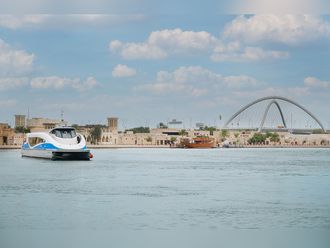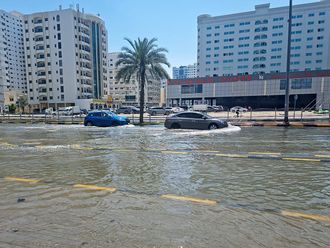
Dubai Take three cladding tiles, add some barbecue fuel and three disposable barbecues, light and let the flames do their work.
The result is a recipe for potential disaster — showing the failings of commonly used building materials to catch fire and spread flames.
Gulf News, with the assistance of Thomas Bell-Wright International Consultants in Ras Al Khor, carried out a non-scientific test on three grades of cladding supplied by Alubond, the Ajman-based manufacturer of the sandwich-style composite aluminium material.
The laboratory in Ras Al Khor is the only fully accredited fire-testing facility in the Middle East, including the larger region.
For a scientific test, the material should be set up and burnt under controlled conditions using the laboratory's Steiner Tunnel — one of just 17 in the world.
"Building owners, project managers and the Civil Defence no longer have to choose between accepting suppliers' representatives or sending the material abroad," Tom Bell-Wright says.
"We can test it in the Steiner tunnel and provide a rating for flame spread and smoke generation which directly correlates to the requiremens of the building code."
Gulf News set up three tile samples — one without any flame-resistant properties, one with fire-retardant properties, and one which is fire-resistant.
Barbecues
Using three small disposable barbecues and some lighter fluid, we set the fires.
After several minutes, nothing was happening. "I'm not surprised," Bell-Wright explains. "There isn't too much heat being generated from the barbecues, and a lot of the heat is being dissipated," he says. "Shall we help it along?"
He squirts each of the three with a lighter fuel. "It's not unrealistic," he says. "Imagine lighting a barbecue on your balcony and you need to add fuel."
After five minutes, the poorest quality begins to buckle slightly. So too does the fire-retardant tile. The fire-resistant one remains as it was.
'Imagine 40 floors of this material'
"That's significant," Clay Salzman, a building code specialist from California and head of Building Inspections at the laboratory, says. "See the way the flames are wicking up the first [non fireproof sample]. It's allowing flames to spread and you can imagine if there was 40 floors of this material, the heat would be moving up the side of the building, creating the ideal conditions for flames to spread."
He holds a thermometer gun to the tiles. There's a 13 degree difference between the fire-resistant sample and the poor quality one, now beginning to show signs of ignition along the bottom edge.
Slowly, the end of the poor-quality one begins to catch fire, flames gradually catching hold on the petroleum-based composite material sandwiched between the aluminium cover.
Aluminium, according to Bell-Wright, won't ignite fully until temperatures reach 260 degrees Celsius. "Quite clearly, the test shows that the non-fireproof one is dangerous and, once it starts, keeps going," Bell-Wright says.
The tile buckles further.
"At this stage, it will likely be dripping flame splatters onto surfaces of anything below it, and will be an ignition for further fires," Salzman says.
Cars went up in flames
In the Al Baker Tower fire two months ago, cars below the building went up in flames when dripping material fell from the burning fire tiles.
In 10 minutes of burning, the point is proved: non-fire-retardant cladding tiles will catch fire and the flames spread.
"You haven't even begun to look at the rest of the materials used in exterior construction," Bell-Wright says. "There's the blackjack sealant paint which is bitumen-based. And then there's the insulation used between the cladding exterior and the building itself. How fire-resistant are those materials?"
Tough questions. So how difficult would it be to put out such a fire?
"We don't fight fires," he quips. "We only start them."












